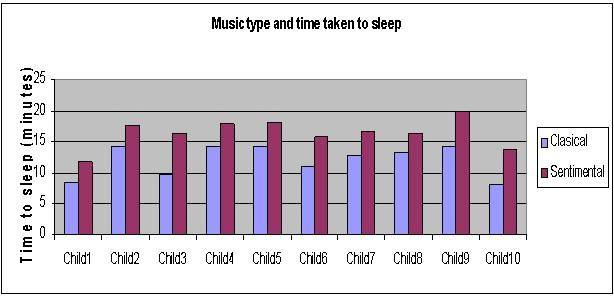| Complexity level: | 5 |
| Project cost ($): | 20 |
| Time required: | 1 hour to prepare, 10 days for the science project experiment |
| Material availability: | Easily found |
| Safety concerns: | Basic safety requirements |
Hypothesis
The children will be able to fall asleep more quickly while listening to classical music as opposed to other types of music.
Overview
Sleep and children
Sleep is a state of unconsciousness. It is when our heartbeat slows down and the body goes into a state of rest Generally, children need more sleep than adults because they are in their growing phase and need to build more bones, tissue and muscles. For example, adults require about 6-7 hours of sleep, older children require about 12 hours of sleep and infants require about 18 hours of sleep.
While babies are still in their mother’s womb, they are listen to their mother’s heartbeat everyday. They are accustomed to soft rhythmic beats in the background. This is why when a crying child is cuddled, the warmth and the familiar sound of its mother's heartbeat calms the child down. When children are made to sleep in a quiet room, this sudden silence might cause fear, discomfort and insecurity. Some background music will help the children to adjust to the quietness of the room, helping them to fall asleep more quickly, and easily.
Scientific Terms
Materials
The materials required for this science fair project are:
- 10 approval slips, to be signed by the children’s parents
- 10 preschoolers age 3 to 4
- 1 classical music CD
- 1 CD of sentimental songs (ballads)
- 1 portable stereo with a CD player
- 1 stopwatch
Procedure
1. The independent variable of this science fair project is the type of music played – classical music or sentimental songs. The dependent variable is the time needed for the children to fall asleep. This is determined using a stopwatch The constants (control variables) are the age of the children, the gender of the children and the conditions in the bed room (bed type and size, airconditioning, lighting, etc).
2. Obtain permission from the management of the nursery to conduct this experiment Should this be approved, send out permission slips to the parents of the children to obtain their permission for involving their children in the experiment.
3. Request that the nursery maintains exactly the same type and intensity of activities for the next 10 days so that the children’s sleep patterns will not be affected by their level of tiredness. Advise the parents to ensure that their children get approximately the same amount of sleep every night.
4. Play classical music during the children’s afternoon nap time on every odd day(Days 1, 3, 5, 7 and 9). Ensure that the music is audible, but not too loud or it might serve to distract or irritate the children. They are made to sleep in the same place and the same, comfortable environment and the time taken for each child to fall asleep is recorded in the table provided below.
5. Play the sentimental ballads during the children’s afternoon nap time on every even day (Days 2,4,6,8 and 10). Ensure that the music is played at the same volume as before. The time taken for each children to fall asleep is recorded in the table provided below

Results
The results show that the children took a shorter time to fall asleep with classical music playing in the background as compared to sentimental music.
| Music | Days | Time taken for child to go to sleep (minutes) | |||||||||
| C1 | C2 | C3 | C4 | C5 | C6 | C7 | C8 | C9 | C10 | ||
| Classical Music |
1 | 7 | 14 | 7 | 15 | 14 | 8 | 14 | 11 | 14 | 8 |
| 3 | 9 | 13 | 9 | 18 | 16 | 15 | 9 | 8 | 17 | 5 | |
| 5 | 8 | 16 | 14 | 13 | 11 | 6 | 16 | 17 | 11 | 9 | |
| 7 | 7 | 13 | 11 | 15 | 14 | 11 | 11 | 15 | 13 | 11 | |
| 9 | 11 | 16 | 8 | 11 | 16 | 15 | 14 | 15 | 16 | 8 | |
| Avg | 8.4 | 14.4 | 9.8 | 14.4 | 14.2 | 11 | 12.8 | 13.2 | 14.2 | 8.2 | |
| Ballad | 2 | 10 | 17 | 14 | 17 | 17 | 15 | 16 | 18 | 19 | 11 |
| 4 | 13 | 19 | 17 | 19 | 17 | 17 | 17 | 16 | 20 | 15 | |
| 6 | 12 | 15 | 15 | 16 | 19 | 14 | 15 | 16 | 21 | 14 | |
| 8 | 11 | 18 | 17 | 20 | 21 | 18 | 19 | 14 | 18 | 17 | |
| 10 | 13 | 19 | 19 | 17 | 17 | 15 | 16 | 18 | 21 | 12 | |
| Avg | 11.8 | 17.6 | 16.4 | 17.8 | 18.2 | 15.8 | 16.6 | 16.4 | 19.8 | 13.8 |
The graph below represents the results of our science experiment.

Conclusion
The hypothesis that children fall asleep more quickly with classical music played in the background, in comparison to sentimental music, is proven to be true.
Also consider
This science fair project can be repeated by varying the type of music being played. Determine if there is a particular tempo or BPM (beats per minute) which children find to be the most soothing.
Besides the genre of music, does the type of instrument that is featured in the music affect our results? Would there be a difference between instrumental music and songs with vocals?
Repeat the experiment with children or even adults of different age groups.
References
Using music to help your infant sleep - http://www.thelaboroflove.com/articles/using-music-to-help-your-infant-sleep/
Toddler insomnia – will using music help baby sleep - http://www.articlesbase.com/sleep-articles/toddler-insomnia-will-using-music-help-baby-sleep-1844886.html

